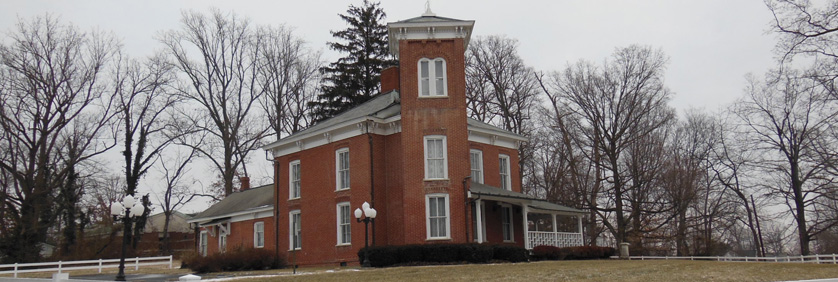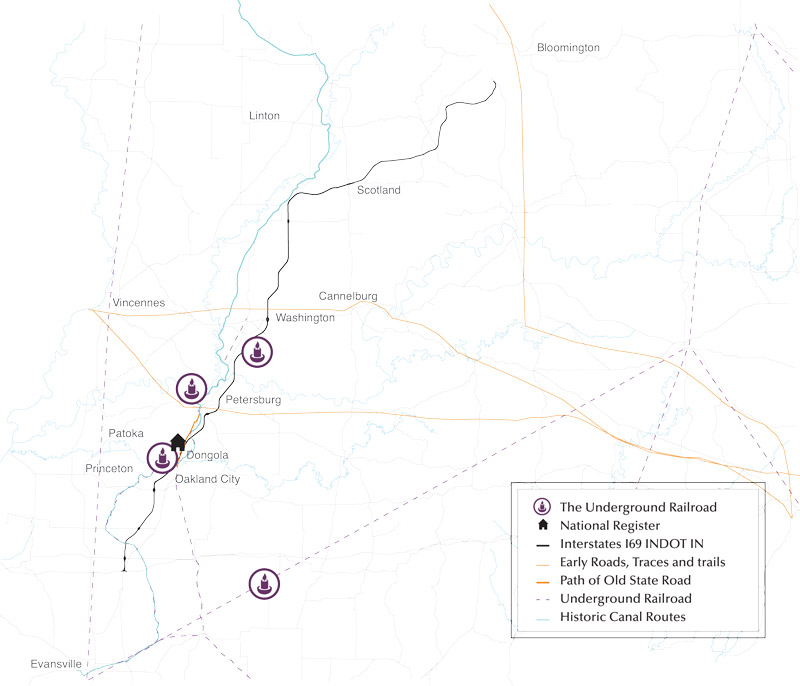As you Travel I-69 north of Evansville, you pass through an area where fugitive slaves reportedly hid and made the trek to freedom, sometimes stopping in Indiana and at other times passing through on their way to Canada. The “Underground Railroad” is one of a series of vignettes that recounts the story of the land between I-64 and Bloomington, Indiana. Choose one or all of the vignettes to learn about the cultural and natural landscape as you Travel I-69.
Observe the following landmarks: Evansville, Oakland City, Dongola, the Patoka River, Petersburg, Washington, and Bloomington. A map also provides locational information.
At the bridge over the Patoka River north of Oakland City, I-69 travels close to the tow-path of the Wabash & Erie Canal and the Evansville and Petersburg Road, formerly known as the “state road.” Fleeing slaves traveled northward to Dongola from three commonly used crossings over the Ohio River: Diamond Island in Posey County, Rockport in Spencer County, and a crossing near Evansville in Vanderburgh County1. To avoid detection, these slaves crossed at Dongola where they hid beneath the covered bridge that once stood at this site2.
In his book published more than sixty years after the event, William Cockrum remembered:
In his book published more than sixty years after the event, William Cockrum remembered: “In 1851 Mr. Andrew Adkins came across the Patoka River at Dongola to see my father. As Mr. Adkins was coming that morning two men from Kirk’s Mills. . .overtook and rode to the bridge with him. They showed him a flaming hand bill giving a description of seven runaway negroes and offering a reward of one thousand dollars for their capture. They informed Mr. Adkins that they, with some others, intended to watch the bridge that night and invited him to assist them, offering to share the reward with him if they got the negroes. Mr. Adkins was very anxious for fear they would catch the negroes and while we were resting after dinner he so expressed himself . . .”—William Cockrum of Petersburg, Indiana, 1915
- Read More

William Cockrum House in Gibson County, Indiana (Weintraut & Associates, Inc.)William Cockrum’s memories were likely obscured by the passage of time and the telling and retelling of the past, but his now well-known account of the Underground Railroad related a story of the Cockrum family’s involvement in the Underground Railroad. Cockrum told his story in his book but the involvement of others, both black and white, has gone largely unrecorded because in many cases, the presence of the runaway slaves was temporary and in all cases, it was illegal.
Thousands of fugitive slaves were ‘recruited’ by Underground Railroad ‘agents’ who explained to them how and where to cross the Ohio River. That agent then passed them along to another
‘agent.’ In this manner, the runaway slaves traveled by night and hid by day. Hiding places were often corn fields or thickets, cellars with hidden doors, barns, or caves.[1]
In 1855, the Evansville Daily Journal reported the capture of escaped slaves at the home of John Carithers [or Carothers] near Princeton, Indiana. According to the article, Carithers was “at first not disposed to surrender them” but in the end he acquiesced.[2] Carithers was lucky; there were no charges brought against him. Not so lucky was Calvin Fairbank, who was imprisoned twice in Kentucky for helping fugitive slaves escape through Indiana and Ohio.[3]
Members of the Anti-Slavery League risked personal liberties to aid the fugitive slaves in their trek to freedom. Less well-known and thus less celebrated, free blacks in Indiana also participated in the movement of slaves north. According to some records, the home of William Hawkins, a free black living in the City of Washington in Daviess County, was a stop on the Underground Railroad.[4]Thomas Cole, an African-American living at the free black Lyles Settlement, also hid runaways as did John Bundy from Kentucky and “Aunty Myrears” in Bloomington.[5] These free blacks risked even more than their white counterparts with their participation in the Underground Railroad.[6]
Cockrum’s account of Petersburg, Indiana, told of the activities of his father, James Cockrum, and other members of the Anti-Slavery League in Pike, Gibson, Warrick, and Posey counties. After crossing into the state, fugitives took a route that brought them into Gibson County, where they hid at James Cockrum’s barn in Oakland City.[7] That barn no longer stands; William Cockrum’s house is listed in the National Register of Historic Places and is stop 11 on the Gibson County Audio Tour at 1-812-774-9304. The town of Oakland City may be accessed from the Oakland City exit.
From Cockrum’s place, fugitives sometimes crossed the Patoka River near Dongola on the “old state road” near the Wabash & Erie Canal. Reports say they hid on occasion under the Dongola Covered Bridge (the site of which is now crossed by a metal truss bridge that can be seen to the east along the long bridge that crosses Patoka River, just north of Mile Marker 46). They then
were conducted northward to Dr. John W. Posey’s coal mine along the banks of the White River in Pike County.[8] From Posey’s coal mine, many crossed the White River into Daviess County before eventually reaching freedom in Canada.
It is clear that the Underground Railroad was active in Indiana in the years prior to the Civil War. Positively identified extant properties associated with the Underground Railroad are few and written records of this movement are so scarce that some historic properties may remain unidentified. Despite these challenges, local historians have identified former barn sites, coal mines, and homes associated with the Underground Railroad. In doing so, these historians ensure that southwestern Indiana’s role in a movement that relied on anonymity will not be forgotten. [9][1] Cockrum, History of the Underground Railroad, 19, 22-25 .
[2] Dr. Randy Mills, et al., “Concerning Underground Railroad Activity in Southwestern Indiana” (Report submitted to the Indiana Department of Natural Resources Division of Historic Preservation and Archaeology: Indianapolis. 2001), 29-30, 32.
[3] Calvin Fairbank, Rev. Calvin Fairbank During Slavery Times (Chicago: McCabe & Co., 1890), 11, accessed September 19, 2019, available at the Hathitrust website, https://babel.hathitrust.org/cgi/pt?id=nyp.33433081794905&view=1up&seq=13.
[4] Henry Lester Smith, “The Underground Railroad in Monroe County,” Indiana Magazine of History, Vol 13, No. 3 (1917), 290, accessed September 18, 2019, available online at https://scholarworks.iu.edu/journals/index.php/imh/article/view/6058/5837.
[5] Mills, “Report Concerning Underground Railroad,” 33; Cockrum, History of the Underground Railroad, 163-181; Smith, “Underground Railroad in Monroe County,” 293.
[6] Mills, “Report Concerning Underground Railroad,” 33; Bury Me in A Free Land Online Exhibit, “The Underground Railroad,” Indiana Historical Bureau, accessed August 27, 2019, https://www.in.gov/history/3119.htm.
[7] Cockrum, History of the Underground Railroad, 19, 69-74.
[8] Cockrum, History of the Underground Railroad, 19-20 and 29-37.
[9] Mills, “Report Concerning Underground Railroad,” 1-15, 19, 24.
Places Of Reported Activity Of The Underground Railroad

